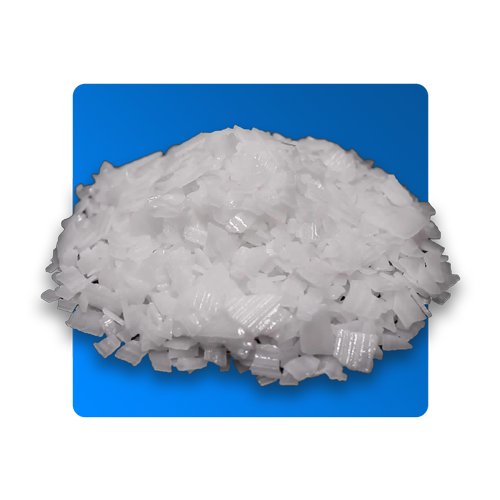Sodium Hydroxide
Sodium hydroxide is sometimes called caustic soda or lye. It is a common ingrediet in cleaners and soaps.
Sodium hydroxide is useful for its ability to alter fats. It is used to make soap and as a main ingredient in household products such as liquid drain cleaners. Sodium hydroxide is usually sold in pure form as white pellets or as a solution in water.
OSHA: The legal airborne
permissible exposure limit (PEL) is 2 mg/m3 averaged over an 8-hour work shift
NIOSH: The recommended airborne
exposure limit (REL) is 2 mg/m3 which should not be exceeded at any time
ACGIH: The threshold limit value
(TLV) is 2 mg/m3 which should not be exceeded at any time

What is sodium hydroxide (NaOH)?
Sodium hydroxide is sometimes called caustic soda or lye. It is a common ingrediet in cleaners and soaps.
At room temperature, sodium hydroxide is a white, odorless solid. Liquid sodium hydroxide is colorless and has no odor. It can react violently with strong acids and with water. Sodium hydroxide is corrosive. NaOH can react with moisture from the air and may generate heat as it dissolves. This heat can be enough to cause a fire if it is near flammable materials.
Sodium hydroxide is useful for its ability to alter fats. It is used to make soap and as a main ingredient in household products such as liquid drain cleaners. Sodium hydroxide is usually sold in pure form as white pellets or as a solution in water.

What are some uses of sodium hydroxide?
Sodium hydroxide is a popular strong base used in industry. Sodium hydroxide is used in the manufacture of sodium salts and detergents, pH regulation, and organic synthesis. In bulk, it is most often handled as an aqueous solution, since solutions are cheaper and easier to handle.
Sodium hydroxide is used in many scenarios where it is desirable to increase the alkalinity of a mixture, or to neutralize acids. For example, in the petroleum industry, sodium hydroxide is used as an additive in drilling mud to increase alkalinity in bentonite mud systems, to increase the mud viscosity, and to neutralize any acid gas (such as hydrogen sulfide and carbon dioxide) which may be encountered in the geological formation as drilling progresses. Another use is in salt spray testing where pH needs to be regulated. Sodium hydroxide is used with hydrochloric acid to balance pH. The resultant salt, NaCl, is the corrosive agent used in the standard neutral pH salt spray test.
Poor quality crude oil can be treated with sodium hydroxide to remove sulfurous impurities in a process known as caustic washing. Sodium hydroxide reacts with weak acids such as hydrogen sulfide and mercaptans to yield non-volatile sodium salts, which can be removed. The waste which is formed is toxic and difficult to deal with, and the process is banned in many countries because of this. In 2006, Trafigura used the process and then dumped the waste in Ivory Coast.
Other common uses of sodium hydroxide include:
- for making soaps and detergents. Sodium hydroxide is used for hard bar soap, while potassium hydroxide is used for liquid soaps. Sodium hydroxide is used more often than potassium hydroxide because it is cheaper and a smaller quantity is needed.
- as drain cleaners that convert pipe-clogging fats and grease into soap, which dissolves in water
- for making artificial textile fibres such as rayon
- in the manufacture of paper. Around 56% of sodium hydroxide produced is used by industry, 25% of which is used in the paper industry.
- in purifying bauxite ore from which aluminium metal is extracted. This is known as the Bayer process.
- de-greasing metals
- oil refining
- making dyes and bleaches
- in water treatment plants for pH regulation
- to treat bagels and pretzel dough, giving the distinctive shiny finish
Saponification
| Mass fraction of NaOH (wt%) | 4 | 10 | 20 | 30 | 40 | 50 |
|---|---|---|---|---|---|---|
| Molar concentration of NaOH (M) | 1.04 | 2.77 | 6.09 | 9.95 | 14.30 | 19.05 |
| Mass concentration of NaOH (g/L) | 41.7 | 110.9 | 243.8 | 398.3 | 572.0 | 762.2 |
| Density of solution (g/mL) | 1.043 | 1.109 | 1.219 | 1.328 | 1.430 | 1.524 |
How might you be exposed to sodium hydroxide?
In the home, some household items like soaps or cleaners contain sodium hydroxide. Accidental ingestion or skin contact with these cleaners could cause harmful exposure.
Some industrial workplaces use sodium hydroxide. Here are some workplace exposure limits to NaOH in the air.
Workplace air exposure limits:
OSHA: The legal airborne
permissible exposure limit (PEL) is 2 mg/m3 averaged over an 8-hour work shift
NIOSH: The recommended airborne
exposure limit (REL) is 2 mg/m3 which should not be exceeded at any time
ACGIH: The threshold limit value
(TLV) is 2 mg/m3 which should not be exceeded at any time
